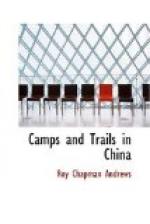MENG-TING: A VILLAGE OF MANY TONGUES
During the eight days in which we remained at the “Good Hope” camp, two hundred specimens comprising twenty-one species were added to our collection. Although the altitude was still 5,000 feet, the flora was quite unlike that of any region in which we had previously collected, and that undoubtedly was responsible for the complete change of fauna. We were on the very edge of the tropical belt which stretches along the Tonking and Burma frontiers in the extreme south and west of the province.
It was already mid-February and if we were to work in the fever-stricken valleys below 2,000 feet, it was high time we were on the way southward. The information which we had obtained near Gen-kang had been supplemented by the natives of Mu-cheng, and we decided to go to Meng-ting as soon as possible.
The first march was long and uneventful but at its end, from the summit of a high ridge, we could see a wide valley which we reached in the early morning of the second day. The narrow mountain trail abruptly left us on a jutting promontory and wandered uncertainly down a steep ravine to lose itself in a veritable forest of tree ferns and sword grass. The slanting rays of the sun drew long golden paths into the mysterious depths of the mist-filled valley. To the right a giant sentinel peak of granite rose gaunt and naked from out the enveloping sea of green which swelled away to the left in huge ascending billows.
We rested in our saddles until the faint tinkle of the bell on the leading mule announced the approach of the caravan and then we picked our way slowly down the steep trail between walls of tangled vegetation. In an hour we were breathing the moist warm air of the tropics and riding across a wide valley as level as a floor. The long stretches of rank grass, far higher than our heads, were broken by groves of feathery bamboos, banana palms, and splendid trees interlaced with tangled vines.
Near the base of the mountains a Shan village nestled into the grass. The bamboo houses, sheltered by trees and bushes, were roofed in the shape of an overturned boat with thatch and the single street was wide and clean. Could this really be China? Verily, it was a different China from that we had seen before! It might be Burma, India, Java, but never China!
Before the door of a tiny house sat a woman spinning. A real Priscilla, somewhat strange in dress to be sure and with a mouth streaked with betel nut, but Priscilla just the same. And in his proper place beside her stood John Alden. A pair of loose, baggy trousers, hitched far up over one leg to show the intricate tattoo designs beneath, a short coat, and a white turban completed John’s attire, but he grasped a gun almost as ancient in design as that of his Pilgrim fathers. Priscilla kept her eyes upon the spinning wheel, but John’s gaze could by no stretch of imagination be called ardent even before we appeared around a corner of the house and the pretty picture resolved into its rightful components—a surprised, but not unlovely Shan girl and a well-built, yellow-skinned native who stared with wide brown eyes and open mouth at what must have seemed to him the fancy of a disordered brain.




